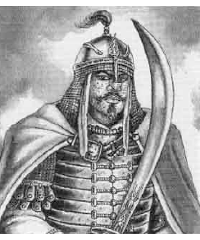Human (Cerilia), Khinasi (Soldier) [1063] 
| Commentaires : This is a short guide to the humans of Cerilia, home of the Birthright setting. As characters from this setting venture forth, they might be encountered nearly anywhere, particularly if interworld gates or far-ranging spelljamming is common. Nearly all of the general types of humans listed in the Human entry exist in Cerilia. |

|
| Combat :
These people come from the region called Khinasi and speak a language called Basarii. They are tall and lanky, with aquiline features and dark eyes. Their complexions range from a light coffee to a dark brown. Men wear loosrfitting breeches of light colored linen or silk, a broad sash of colorful fabric, and a tight-fitting high-collared shirt with half- or three-quarter length sleeves. Colorful vests are common and wealthy men wear lavishly decorated shoes. Womenís dress is similar, but cover the legs to the ankle and arms to the wrist for decency. It is considered improper for either gender to appear in public without a head covering, generally a cap, scarf, turban, or light veil. Unlike the other human cultures of Cerilia, the Khinasi have no fear of magic. The study of magic is considered the noblest of callings, but raising or communicating with the dead is strictly forbidden. Khinasi bards are not respected, being mostly poor wanderers of dubious honesty. They lack the status of Anuirean bards, and are commonly considered vagrants and thieves. Professional storytellers, however, are highly respected. Thievesí guilds are vigorously rooted out by Khinasi city governments, though some operate succesfully. The culture has a long tradition of hidden cults and guilds of assassins, though most Khinasi view their activities with horror. Like the Brechts, Khinasi commoners are traders and merchants, but an individualís decorum, hospitality, conduct, and ability to entertain lavishly are far more important than wealth. Piety, politeness, and eloquence mark high breeding and wisdom, and Khinasi disputes are marvels of suggestion. Khinasi agpssively assimilate aspects of other cnltures they find useful, yet maintain a core lifestyle that is their own. Many Khinasi sprinkle everyday speech with brief prayers for success in routine ventures, blessings on passing strangers, and invocations of divine favor for great enterprises. Swearing in a deityís name is a horribly crude and barbaric act. Slavery is unknown; a person of skill might rise without limit with hard work and a little luck. Khinasi rulers are skilled in diplomacy and subtle. The highest noble titles include emir, satrap, sultan, and khan. In war, the nobles fight as mailed cavalry mounted on medium horses, armed with lance, scimitar (or saber), and javelins. Khinasi professional warriors wear chain mail and carry scimitars, while Khinasi militia is generally unarmored. Typical militia weapons include spears, clubs, daggers, and composite bows. Seafarers and herders typically wear leather armor and might carry a cutlass or short sword, sling, or dagger. A typical Khinasi field force has 30% medium cavalry, 20-30% light cavalry, and 40-50% split between spear-armed militia levies, archery, and irregular light troops such as hillmen or marines. Paladins are as common as in Anuirean armies, rangers tend to be from hills or deserts instead of forests. |